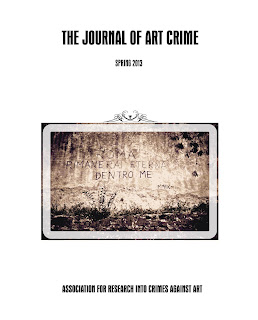Tuesday, July 30, 2013 -  Christos Tsirogiannis,Crispin Corrado,Marc Balcells,Noah Charney,Spring 2013,the Journal of Art Crime
Christos Tsirogiannis,Crispin Corrado,Marc Balcells,Noah Charney,Spring 2013,the Journal of Art Crime
 No comments
No comments
 Christos Tsirogiannis,Crispin Corrado,Marc Balcells,Noah Charney,Spring 2013,the Journal of Art Crime
Christos Tsirogiannis,Crispin Corrado,Marc Balcells,Noah Charney,Spring 2013,the Journal of Art Crime
 No comments
No comments
The Journal of Art Crime: Issue 9, Spring 2013
The ninth issue of The Journal of Art Crime, edited by Noah Charney and published by ARCA, is available electronically (pdf) and in print via subscription and Amazon.com. The Associate Editor is Marc Balcells (ARCA '11), Graduate Teaching Fellow, Department of Political Science, John Jay College of Criminal Justice -- The City University of New York.
The Editorial Board includes Lord Colin Renfrew, Professor of Archaeology, University of Cambridge; Petrus van Duyne, Professor of Criminology, University of Tilburg, The Netherlands; Matjaz Jager, Director, Institute of Criminology, Slovenia; Travis McDade, Professor of Library Studies, University of Illinois Law School, US; Kenneth Polk, Professor of Criminology, University of Melbourne, Australia; David Simon, Professor of Art History, Colby College, US; Erik Nemeth, RAND Group, US; Liisa van Vliet, University of Cambridge, UK; Dick Drent, Director of Security, the Van Gogh Museum, The Netherlands; Anthony Amore, Director of Security, Isabella Stewart Gardner Museum, US; Dennis Ahern, Director of Security, the Tate Museums, UK; Richard Ellis, Director, ArtResolve and Art Risk Consultant, UK; Col. Giovanni Pastore, Retired, Carabinieri Division for the Protection of Cultural Heritage, Rome, Italy; Neil Brodie, Professor of Archaeology, University of Glasgow, UK; David Gill, Professor of Archaeology Heritage at University Campus Suffolk, UCS Ipswich, UK; A. J. G. Tijhuis, Attorney, Pontius Lawyers, and NSCR, Amsterdam, The Netherlands; Benoit van Asbroeck, Attorney, Bird & Bird, Brussels, Belgium; and Howard Spiegler, Attorney, Herrick, Feinstein LLP, US.
Design, layout and the cover design and illustration created by Urska Charney.
In the "Letter from the Editor", Noah Charney, Found of ARCA, writes:
In this issue, we present six academic articles, rather than our usual 4 or 5. We had a cornucopia of strong and timely submissions, and so chose to run extra academic articles and have slightly fewer editorials in this issue. Also unusually, we've published several papers by young Greek scholar Christos Tsirogiannis, who has uncovered some timely, breaking-news information about antiquities auctioned by Christie's, as well as new info about a statue at the Virginia Museum of Fine Arts. His scholarship is top level, but also fresh and current, so we felt it wise to run both of his articles now, allowing The Journal of Art Crime, to "break" his stories. We also feature a strong contribution from Anna Perl, on restitution issues in Poland, a new translation of an article on the philosophy and theory of authenticity, from Thierry Lenain, and a fine dissertation from an ARCA Program graduate, Caitlin Willis. Finally, in the Academic section, we offer the first in a series of articles by Dutch lawyer and criminologist Edgar Tijhuis, adapted from his out-of-print book, Transnational Organized Crime and the Interface between Legal and Illegal Actors. This text will be serialized in consecutive issues of the JAC.
This issue also includes a Letter from ARCA's Acting Academic Director, Crispin Corrado, PHd in Classical Archaeology from Brown University, and author of a book on ancient Roman sculpture, Merry and Jovial: Reconsidering the Effigies Immortalis and the Commemoration of Roman Boys (Oxbow Books, 2013).
Academic Articles: Christos Tsirogiannis' "Something is Confidential in the State of Christie's"; Thierry Lenain's "The Question of the Value of Doubles in Autographic Arts"; Caitlin Willis' "Graffiti in Contemporary Rome: Why Reductive Solutions will Fail and Why that's a Good Thing"; Anna A. Perl's "Poland's Restitution Efforts in the United States"; Tsirogiannis' "A Marble Statue of a Boy at the Virginia Museum of Fine Arts"; and Edgar Tijhuis' "Legal and Illegal Actors around Art Crime: a Typology of Interfaces".
Regular Columns: David Gill on "Dallas Museum of Art Takes the Initiative" in Context Matters; Christopher Marinello on "Art Recovery: Negotiating with Criminals, Handlers, and Good Faith Purchasers"; and Noah Charney on "New "Intelligence" Body Will Monitor Illegal Traffic in Cultural Property" in Lessons from the History of Art Crime.
Editorial Essays: David Scott's "On Art Forgery: the History of a Modern Obsession by Thierry Lenain"; Steven D. Feldman (Herrick, Feinstein LLP) on "Highlights of Selected Criminal Cases Involving Art & Cultural Objects: 2012"; Stefano Alessandrini's "The Thieving Director: the Horrifying Theft of Thousands of Books, and the Thief who was Paid to Protect Them"; and Elizabeth Rynecki's "Lost, Forgotten, Looted, or Destroyed: A Great-Granddaughter's Search for her Art Legacy".
Reviews: Marc Balcells reviews Por amor al arte: Memorias del ladrón más famoso del mundo by Erik el Belga; Catherine Schofield Sezgin reviews The Buddhas of Bamiyan by Llewelyn Morgan; Balcells reviews The Illicit Trade in Art and Antiquities by Janet Ulph and Ian Smith; and Sezgin reviews Forged: Why Fakes Are The Great Art of Our Age by Jonathon Keats.
Extras: Noah Charney's "Q&A with Ruth Godthelp" and "Q&A with Ken Perenyi"; 2013 ARCA Awards.





